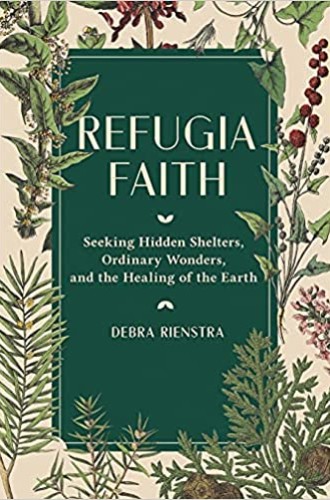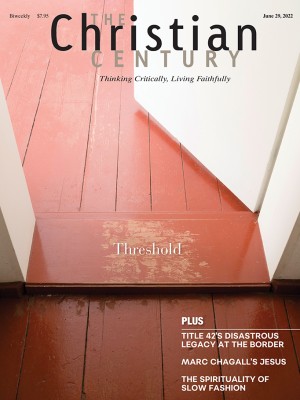Climate change requires adaptive faith
Debra Rienstra urges Christians to create spaces of transition and new growth wherever we are.
Though I’ve been nurtured in various Christian traditions for over two decades, I confess that in recent years I’ve wondered whether the faith has anything to offer in our time of planetary crisis. I’ve observed, like Calvin University English professor Debra Rienstra, how in Christian circles the natural world tends to serve as a backdrop to the (supposedly) main drama of the human-Divine relationship. I’ve noticed congregations intellectually assent to our God-given roles as stewards of the earth while remaining disturbingly complacent about our current global path toward mass species extinction and climate chaos. And, like Rienstra, I’ve witnessed the most poignant examples of lament, courage, and love for creation coming from outside the institutional church.
I’m teetering at the edge of organized Christianity because of all this, wondering if the spiritual resources needed for this moment might be found elsewhere. Rienstra, however, reaches deep down into her faith. Answering the call of self-identified “geologian” Thomas Berry that humans must do the “Great Work” of transitioning from our destructive ways to cooperation with the whole earth community, she asks, “How must we adapt Christian spirituality and practice in order to become healers of this damaged earth?”
Read our latest issue or browse back issues.
The question is essential for those who find themselves squarely within organized traditions—if these traditions are to preserve any credibility in the decades to come. Also, for someone like me who is halfway out the church door, hearing someone on the inside pose this question halts my step. Maybe I’ll sit in the back pew long enough to hear an answer.
Rienstra is a descendant of the Reformed tradition, a White woman, and, in her words, an “oldster.” Her roots in western Michigan go back just a couple generations, but she acknowledges that her family inherited the legacy of previous White settlers, who cleared forests of beech and sugar, of oak and hickory, and then paved the land with highways, strip malls, climate-controlled homes, and other modern conveniences. Rienstra wrestles honestly with benefiting from all of this so-called progress while also feeling the resulting disconnect from the land and its more-than-human inhabitants.
“They’ll think of something,” Rienstra quotes her mother saying in the face of any complex problem, noting that her parents, who died in 2015, lived through an apparent sweet spot of human optimism. In 2022, at a point of crisis convergence, Rienstra offers what is, I believe, the only appropriate rejoinder to that common posture of coasting on someone else’s problem-solving: “I realize as never before in my life that I must become a better citizen. I can’t rely, with a wan smile and a shrug—as my mother did—on the assurance that ‘they’ll think of something.’ ‘They’ is us. ‘They’ is me.”
What each of us will do with this realization is the next question. Rienstra offers examples from her own corner of the planet—actually, her own backyard—of ways she is going about the “little work” of putting her own abilities and energy in the service of the “Great Work.” She’s cutting back the invasive buckthorns and planting a native garden. She’s learning her state’s natural history. She’s learning from Black and Indigenous leaders who have long practiced lament, survival, and enduring. She’s naming plants and identifying birdcalls.
Because Rienstra is not an ecologist or any other kind of nature expert, her fledgling efforts feel relatable to me. Her tender and humorous accounts make the work approachable to those of us who haven’t been trained (by our education or by our communities) to pay attention to the startling “beingness” of the lifeforms just outside our back door.
Rienstra also follows the advice of climate writer Mary Annaïse Heglar to “do what you’re good at. And do your best.” In Rienstra’s case, that’s theology and literature. She takes the biological concept of refugia—places where plants and animals shelter during changing environmental conditions to regrow once there is an opportunity—and finds biblical and cultural parallels. Christ’s incarnation, crucifixion, and resurrection, for instance, show that “God loves to work with scraps and remnants, the most unlikely materials possible. . . . Refugia faith attends to the miracle of the seed.”
In our churches, in our communities, and in our ecosystems, Rienstra says, Christians are being called to nurture refugia—inclusive spaces where transition, healing, and new growth can occur. Rienstra applies the concept broadly, from the forest churches of Ethiopia to virtual groups of like-minded people. In fact, it seems that almost anything can become a refugium, which is perhaps the point: God intends for life to persist and thrive. Everywhere.
But somehow, despite the concept’s universality, Rienstra notes that “Christian groups in North America have not, overall, been acting as the people of refugia.” I was curious to see what Rienstra would do here with the sovereignty of God, a favorite doctrine of Reformed folks. In fact, she does take the time to unpack ideas about God’s kingship, which tend to translate into a kind of passive, infantile submission to “God’s will.” We would be better off, she writes, replacing that top-down image with the image of Christ at the center. Understanding ourselves in a “community of equality and connection,” Rienstra argues, corrects our misshapen ideas of God’s sovereignty. In her view, sovereignty doesn’t mean deterministic control; it’s about provision and meaning. God is still at work, even here, in this hidden, remnant corner.
Rienstra articulates all of this beautifully. But she admits that “how a refugia paradigm might renew worship practices or church structures—those are topics for another book.” We’ll see if congregations digest and apply a refugia faith soon enough for people like me, seeking spiritual courage for our crisis times, to find it in the pews.
A version of this article appears in the print edition under the title “Adaptive faith.”







